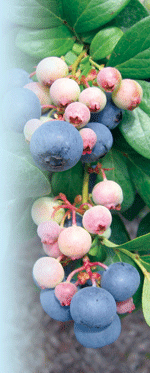Blueberries in the Landscape
go.ncsu.edu/readext?234350
en Español / em Português
El inglés es el idioma de control de esta página. En la medida en que haya algún conflicto entre la traducción al inglés y la traducción, el inglés prevalece.
Al hacer clic en el enlace de traducción se activa un servicio de traducción gratuito para convertir la página al español. Al igual que con cualquier traducción por Internet, la conversión no es sensible al contexto y puede que no traduzca el texto en su significado original. NC State Extension no garantiza la exactitud del texto traducido. Por favor, tenga en cuenta que algunas aplicaciones y/o servicios pueden no funcionar como se espera cuando se traducen.
Português
Inglês é o idioma de controle desta página. Na medida que haja algum conflito entre o texto original em Inglês e a tradução, o Inglês prevalece.
Ao clicar no link de tradução, um serviço gratuito de tradução será ativado para converter a página para o Português. Como em qualquer tradução pela internet, a conversão não é sensivel ao contexto e pode não ocorrer a tradução para o significado orginal. O serviço de Extensão da Carolina do Norte (NC State Extension) não garante a exatidão do texto traduzido. Por favor, observe que algumas funções ou serviços podem não funcionar como esperado após a tradução.
English
English is the controlling language of this page. To the extent there is any conflict between the English text and the translation, English controls.
Clicking on the translation link activates a free translation service to convert the page to Spanish. As with any Internet translation, the conversion is not context-sensitive and may not translate the text to its original meaning. NC State Extension does not guarantee the accuracy of the translated text. Please note that some applications and/or services may not function as expected when translated.
Collapse ▲
Bill Cline ©
Blueberries, Vaccinium sp., are one of the few plants that offer both beauty and taste throughout most of the year. The actual blueberry fruit is touted by the National Institutes of Health as a way to delay the aging process. Blueberries are nutritional stars, providing a powerhouse boost of antioxidants and nutrients without adding many calories. So why not plant them in your home landscape?
Blueberries are typically used in the landscape as hedges for screening purposes, but they can also be used in cluster plantings or as single specimen plants. Blueberries are spectacular in the fall with brilliant yellow and red foliage that lights up the landscape. They have attractive, bell-shaped, white and occasionally pink flowers in the spring. The summer fruit is a dark purplish blue. An added bonus is their lack of disease and insect problems.
Blueberries require a lower pH than many other small fruit crops and other plants. Therefore, consider grouping them with other acid-loving plants such as hollies, azaleas, rhododendrons and camellias. Before planting, take a soil test. The ideal pH for blueberries is between 4.0 and 5.0 or 5.5, depending on the cultivar.

Bill Cline ©
Both the highbush and rabbiteye types grow well in North Carolina. Highbush typically have larger fruit and better fruit quality than rabbiteyes, but are not as widely adapted to various soil types. The cultivar ‘Premier’ is an excellent choice for a rabbiteye and has the added advantage of being self-fruitful, unlike most blueberries that require cross-pollination for fruit set.
Dr. Jim Ballington, NC State University horticulture professor, has developed a series of Southern highbush blueberries that retain the high fruit quality of standard highbush but demonstrate greater adaptation to a wider range of soil types. Cultivars ‘O’Neal,’ ‘Sampson,’ and ‘Legacy’ are good choices. Little annual attention is required, except for occasional pruning.


